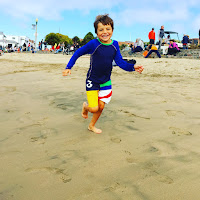Sunday, July 17, 2016
Way Up High
The beauty of living in the hills above San Carlos depends on which mountain you sit upon, because you can view San Francisco or Palo Alto and even deep into the apartments of San Jose. The thrill of living in homes with views is that once you've owned one, it's immensely difficult to live anywhere else. The air is better up here, of course, and so is the weather. Food tastes better. People are friendlier. Most people who own homes with majestic views shun the television and prefer the pursuit of the great outdoors. Why would you waste time watching a big screen TV seated on a sofa drinking soda or beer and getting FAT when you could be outside enjoying California's golden sunshine? Tonight we hiked a trail in our backyard and picked fresh berries off the vine. This area is also well known for high-calibre public schools. My son begins kindergarten in a few months and he is ready for it. As for now, we are happy to be nestled on this beautiful mountain. Ha.
Thursday, July 7, 2016
If The Music Is Good We Dance
V.R.
experiences, as they’re often called, can be fictional or journalistic,
narrative or open-ended. They can look like small-budget movies, big-budget
video games or experimental art pieces with no obvious precedent. Some are
called cinematic V.R. or V.R. storytelling, to distinguish them from pieces
made for more practical ends, such as architectural modeling or P.T.S.D.
therapy.
One of
the main challenges for storytellers is learning to think in terms of spheres
instead of rectangles. Cinematic grammar no longer applies. There is no frame
in which to compose a shot. An actor who directly addresses the camera isn’t
breaking the fourth wall, because the viewer is already in the middle of the
action. The viewer can look anywhere, so the director often adds subtle visual
or auditory cues to indicate where to look, or to signal that the viewer’s gaze
can wander without missing anything important.
Tracking
shots must be steady and slow, because too much camera movement can cause
discomfort—viewers have reported headaches, vertigo and nausea. For the same
reason, most V.R. experiences last only a few minutes; more sustained stories
tend to be divided into episodes. In “passive” V.R. experiences, you simply
enjoy the ride; in “interactive” ones, the environment responds to your
choices. Some interactions are simple, relying on nothing more than the
orientation of the viewer’s head. In an elegant game called Land’s End, you
look around a serene, vividly colored landscape until you see a white orb
floating at eye level. If you stare at the orb long enough, it pulls you inside
it. Then you look for the next orb, which pulls you forward, and so on; without
instruction, you intuitively navigate your way through a V.R. environment.
Other interactive experiences use more complex hardware, including hand
controllers and body-tracking sensors, to simulate such activities as painting
and mini-golf.
More
sophisticated V.R. headsets have been available to developers for about two
years, in prototype form and are now reaching the market. The Oculus Rift,
which produces precise localized audio, sells for six hundred dollars. The HTC
Vive, a “room-scale” system that uses laser emitters to track a user’s movement
within a fifteen-by-fifteen-foot space, costs eight hundred as does LeEco's ExploreVR.
The tech
is advancing astoundingly quickly.
Humans are good at picking up language, including visual language, but first it
has to be invented. Television broadcasting began in the nineteen-twenties, but
it took decades for TV to become a medium. In the thirties, actors were filmed
standing in front of microphones as they read scripts of radio plays. Movies
also began as filmed theatre, but directors learned to use the camera to
heighten emotions. To represent James Stewart’s fear of heights in “Vertigo,”
Alfred Hitchcock introduced the “dolly zoom,” in which the cinematographer
moves the camera backward while zooming in or vice versa. The dolly zoom came
to signify a moment of great revelation or terror, and it was used at pivotal
points in motion pictures “Raging Bull,” “Pulp Fiction,” and “Poltergeist.”
It’s not clear whether zoom lenses can be used in V.R.; as far as I know, no
one has tried yet. Nor do V.R. directors use montages, dissolves, or split
screens—though these are all technically feasible, they might seem abrupt or
confusing to the audience, who are learning to watch V.R. while its makers are
learning to make it. There’s minimal editing, because we’re still figuring out
how to do it. Other V.R. directors are experimenting with what might be called
a leap cut, in which the viewer is transported, sometimes with an audible whoosh,
from one part of the scene to another. We’re watching the semiotics come
together in front of our eyes.
For most
people, normal reality is virtual reality. Current reality is the matrix
of all possibilities. Eventually, V.R. software could be calibrated to the
user’s body: there might be ways to keep track of pulse, or galvanic skin
response and deliver different experiences in reaction to that.
Outside of fiction, "virtual reality," like "angel food" or "infinity pool," is an evocative phrase that can be disappointing if taken literally. An Oculus headset provides no taste and no touch and it registers only head and hand movement. You never fully lose yourself in the simulation, if only because you're worried that it's impossible to look respectable wearing a plastic face mask. Primitive head-mounted displays were invented more than half a century ago. The Headlight, built by Philco, in 1961, used magnetic head tracking and separate video projections for each eye. There was a wave of V.R. hype in the eighties and another one in the nineties, but only now has the technology become sophisticated enough for the wave to crest.
Outside of fiction, "virtual reality," like "angel food" or "infinity pool," is an evocative phrase that can be disappointing if taken literally. An Oculus headset provides no taste and no touch and it registers only head and hand movement. You never fully lose yourself in the simulation, if only because you're worried that it's impossible to look respectable wearing a plastic face mask. Primitive head-mounted displays were invented more than half a century ago. The Headlight, built by Philco, in 1961, used magnetic head tracking and separate video projections for each eye. There was a wave of V.R. hype in the eighties and another one in the nineties, but only now has the technology become sophisticated enough for the wave to crest.
Tuesday, July 5, 2016
A Future You Can Believe In: See, Discover, Dream And Create
My son is fascinated by water. He loves to swim in it even if it's ice cold in a refreshing sort of way. We both know that summer has arrived
in an eternal sense when we are spending time together at the beach. My son is
a tall, athletic, energetic and handsome five years young. He loves to spend
the early part of an afternoon learning how to be properly dashing into the
waves—running in and out of them with such energetic force that seawater
streams from his nose. Or running into the ocean till he is fully submerged and swimming back
to the shore. Although he is a good swimmer, I often have to get into the ocean
with him just to make sure. Then the tide starts coming in, and it becomes time
to build sand castles.
Here is an essential human pleasure: to fill your hand with
sand, turn it over, and call it architecture. We pick a spot. It is prime sand
real estate—towards the top of the hill, with perfectly sloping moist sand—but
also, high risk: our work once complete would in time fall as the tide returned.
In only a few minutes, Cadence has flung together a hamlet of sand mounds
protected by a low, curving wall. I dig a moat in front of it, to slow the
first waves when they come, and build a break-wall in front of that. My son
looks on with gleeful amazement. “We always have this much fun!” he declares
with delight.
Nietzsche once argued that you can gauge a man’s relationship to
time by the way he builds a sand castle. The first man, he wrote, will proceed
hesitantly, intent on craft, fretting all the while about the inevitable return
of the waves and shocked by his loss when they finally arrive. A second man
won’t even start building: Why bother if the tide will only destroy it? The
third—the paragon of manhood, in Nietzsche’s view—embraces the unavoidable and
throws himself into the work regardless, joyful though not oblivious.
I would like to think that I belong to this third category, and
I see myself all too keenly in my son. He has started his own construction
project—a small mound that he had patted and sculpted into some elegant
shape—beyond the protective wall of the sand town.
My
son stands facing the waves, his arms outstretched, the grin of ages on his
face. He is a giant. He always looks happy, and I love every moment we spend
together on the beach in Aquatic Park in San Francisco.
Sunday, July 3, 2016
Jumping In Puddles: USA Represented By 52 Crews At The 2016 Henley Royal Regatta
Rowing is a sport, unlike others, that places
endurance, physical fitness, teamwork and commitment to the crew above all
else. There are no personal victories or losses. The crew wins together, and
the crew loses together. Responsibility is endured by all, equally, always. The
very embodiment of rowing is the challenge if offers to the human spirit – to
push and pull in pursuit of a higher level of excellence, to go beyond the
limitations of individuality where the rules and pace of the game are set by
none other than the crew as a whole.
At the 2016 Henley Royal Regatta, 52 crews
represented the USA from 31 different rowing clubs and universities. Fresh from
victory at IRA's the University of California was entered in the Visitors',
Temple, Ladies' and Diamond Cup. In the Grand Challenge Cup, the New York Athletic
Club was entered to compete as were US Rowing training center's women' eight
who had won gold at world's in Lucerne just prior to the regatta. While
American crews only represent a small portion of the competition at Henley, USA
rowers performed well.
This year's Henley Royal Regatta was not
short on excitement, crashes, upsets and even controversy. The second year of
Sir Steve Redgrave's tenure as Regatta chairman has seen a record entry of 629
crews, including 52 US crews–in itself a record, and up 45% on last year's
figure of 114. There is something special about Henley. Or rather, many things.
It's unique in the rowing world in terms of both its format as well as bringing
together virtually every level of the sport. It's among the world's most
historic and historically significant sporting events. And this year was
certainly one for the ages.
The last twelve months have seen two key
factors that have contributed to the Henley’s popularity. First, the award-winning
live coverage on YouTube and on Facebook has been widely lauded. Second, aside
from the Olympic Regatta, perhaps no other coverage has ever captured the sport
in such idyllic style, with the aerial drone coverage illustrating both the
nature of the course and the beauty of this famous stretch of the River Thames.
It's a great art, is rowing. It's the finest art there is. It's a symphony of
motion. And when you are doing well, why it's nearing perfection. And when you
reach perfection, you're touching the divine. It touches the you of you, which
is your soul. This is why we row.
Subscribe to:
Posts (Atom)
































